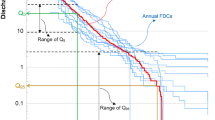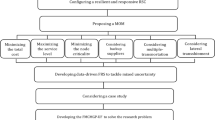Abstract
We consider the management of a single hydroelectric dam, subject to uncertain inflows and electricity prices and to a so-called “tourism constraint”: the water storage level must be high enough during the tourist season with high enough probability. We cast the problem in the stochastic optimal control framework: we search at each time t the optimal control as a function of the available information at t. We lay out two approaches. First, we formulate a chance-constrained stochastic optimal control problem: we maximize the expected gain while guaranteeing a minimum storage level with a minimal prescribed probability level. Dualizing the chance constraint by a multiplier, we propose an iterative algorithm alternating additive dynamic programming and update of the multiplier value “à la Uzawa”. Our numerical results reveal that the random gain is very dispersed around its expected value; in particular, low gain values have a relatively high probability to materialize. This is why, to put emphasis on these low values, we outline a second approach. We propose a so-called stochastic viability approach that focuses on jointly guaranteeing a minimum gain and a minimum storage level during the tourist season. We solve the corresponding problem by multiplicative dynamic programming. To conclude, we discuss and compare the two approaches.












Similar content being viewed by others
Notes
Even if it was not the case in the data provided by Electricité de France.
The abbreviation w.r.t. stands for “with respect to”.
Whereas it would correspond to the Decision-Hazard framework if \( \mathbf {U}_{t} \) were measurable w.r.t. \( \sigma \left( \mathbf {W}_{0}, \, \ldots , \, \mathbf {W}_{t-1} \right) \) (see [7]).
The abbreviation s.t. stands for “such that”.
The gradient step method for the dual minimization problem may be replaced by a more efficient method such as dichotomy, conjugate gradient or quasi-Newton.
Otherwise, the multiplier goes to infinity with the iteration index, which means that Constraint (9f) is infeasible.
Although this assumption is by no means required.
See Remark 2 for the influence of these discretization choices on the quality of the solution.
We could consider that the set in which \( \mathbf {S}_{t} \) takes its values might vary with respect to t. This would certainly reduce the algorithm running time, but it would not reduce it by orders of magnitude.
References
Van Ackooij, W.: Chance Constrained Programming with applications in Energy Management. PhD thesis, École Centrale des Arts et Manufactures (2013)
Van Ackooij, W., Zorgati, R., Henrion, R., Möller, A.: Joint chance-constrained programming for hydro reservoir management. Optim. Eng. 15, 509–531 (2014)
Alais, J.C.: Risque et optimisation pour le management d’énergies: application à l’hydraulique. PhD thesis, Université Paris-Est (2013)
Andrieu, L., Henrion, R., Römisch, W.: A model for dynamic chance constraints in hydro power reservoir management. Eur. J. Oper. Res. 207, 579–589 (2010)
Charnes, A., Cooper, W.W.: Chance-constrained programming. Manag. Sci. 6, 73–79 (1959)
Carpentier, P., Chancelier, J.-P., Cohen, G., De Lara, M., Girardeau, P.: Dynamic consistency for stochastic optimal control problems. Ann. Oper. Res. 200, 247–263 (2012)
Carpentier, P., Chancelier, J.-P., Cohen, G., De Lara, M.: Stochastic multi-stage optimization. At the crossroads between discrete time stochastic control and stochastic programming. Springer, Berlin (2015)
De Lara, M., Doyen, L.: Sustainable management of natural resources: mathematical models and methods. Environmental science and engineering. Springer, Berlin (2008)
Dentcheva, D.: Optimization models with probabilistic constraints. In Lecture Notes on Stochastic Programming Modeling and Theory, pp. 87–153 (2009)
Doyen, L., De Lara, M.: Stochastic viability and dynamic programming. Syst. Control Lett. 59(10), 629–634 (2010)
Dupačová, J.: Stability and sensitivity analysis for stochastic programming. Ann. Oper. Res. 27(1), 115–142 (1990)
Ekeland, I., Temam, R.: Convex analysis and variational problems. Studies in mathematics and its applications. North-Holland Pub Co., New York (1999)
Everett, H.: Generalized Lagrange multiplier method for solving problems of optimum allocation of resources. Oper. Res. 11, 399–417 (1963)
Henrion, R.: On the connectedness of probabilistic constraint sets. J. Optim. Theory Appl. 112(3), 657–663 (2002)
Henrion, R.: A critical note on empirical (sample average, Monte Carlo) approximation of solutions to chance constrained programs. In:Homberg, D., Troltzsch, F. (eds.) System Modeling and Optimization. IFIP Advances in Information and Communication Technology, vol. 391,pp. 25–37. Springer, Hidelberg (2013)
Henrion, R., Römisch, W.: Hölder and Lipschitz stability of solution sets in programs with probabilistic constraints. Math. Program. 100(3), 589–611 (2004)
Infanger, G., Morton, D.P.: Cut sharing for multistage stochastic linear programs with interstage dependency. Math. Program. 75(2), 241–256 (1996)
Luedtke, J., Ahmed, S.: A sample approximation approach for optimization with probabilistic constraints. SIAM J. Optim. 19(2), 674–699 (2008)
Maceira, M.E., Damazio, J.M.: The use of PAR(p) model in the stochastic dual dynamic programming optimization scheme used in the operation planning of the Brazilian hydropower system Operation Planning Studies of the Brazilian Generating System. In: IEEE 8th International Conference on Probabilistic Methods Applied to Power Systems,pp. 397–402, Ames, Iowa, (2004)
Miller, L.B., Wagner, H.: Chance-constrained programming with joint constraints. Oper. Res. 13, 930–945 (1965)
Ono, M., Kuwata Y., Balaram J.: Joint chance-constrained dynamic programming. In: 51st IEEE Conference on Decision and Control, pp. 1915–1922. Maui, Hawaii (2012)
Prékopa, A., Szántai, T.: On optimal regulation of a storage level with application to the water level regulation of a lake. Europ. J. Oper. Res. 3(3), 175–189 (1979)
Prékopa, A.: Stochastic Programming. Mathematics and Its Applications. Kluwer Academic Publisher, Dordrecht (1995)
Prékopa, A.: Probabilistic programming. In: Ruszczynski, A., Shapiro, A. (eds.) Stochastic Programming. Handbooks in Operations Research and Management Science, vol. 10, pp. 267–351. Elsevier, Amsterdam (2003)
Acknowledgments
The authors thank Electricité de France Research and Development for initiating this research through the CIFRE PhD funding of Jean-Christophe Alais and for supplying us with data.
Author information
Authors and Affiliations
Corresponding author
Rights and permissions
About this article
Cite this article
Alais, JC., Carpentier, P. & De Lara, M. Multi-usage hydropower single dam management: chance-constrained optimization and stochastic viability. Energy Syst 8, 7–30 (2017). https://doi.org/10.1007/s12667-015-0174-4
Received:
Accepted:
Published:
Issue Date:
DOI: https://doi.org/10.1007/s12667-015-0174-4




